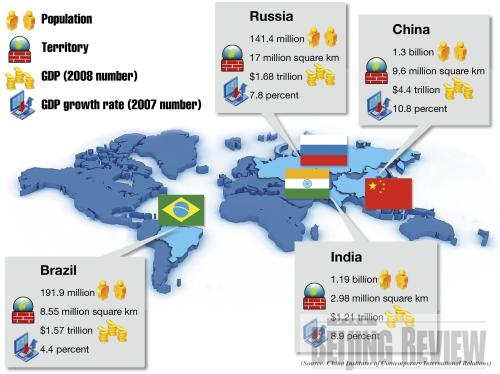| 
The BRIC—Brazil, Russia, India and China—are the four most vigorous economies in today's world. They are playing a more and more important role in the global economy.
Common traits
The four economies have several things in common.
The most obvious one is their rapid economic development. Covering one fourth of the world's total territory, the BRIC countries altogether have 42 percent of the world's total population. Statistics show that foreign exchange reserves of rising economies, including the BRIC countries, have continued to grow in recent years, occupying three quarters of the world total. China, India and Russia all have huge foreign exchange reserves. China has demonstrated tremendous economic development for more than 30 years. The Indian economy has also seen outstanding growth during the past decade, maintaining an average annual growth rate of 6 percent to 7 percent. In 2007, its growth rate even reached 8.9 percent. Investment in the two countries is now behind only the United States. The Russian economy has also experienced high-speed development during the past eight years, with an average annual gross domestic product (GDP) growth rate of 7.8 percent. The country's rapidly growing foreign exchange reserve has enabled it to pay off almost all its $200 billion foreign debt left over from Soviet administrations. Now it is back on the list of the world's top 10 economies. Compared with the above three economies, the Brazilian economy is developing at a relatively slower pace. Nonetheless, its economic growth rate in 2007 was 4.4 percent.
Goldman Sachs predicted that the global economic growth rate in 2009 will be only 0.6 percent, and the growth rate of developed economies will shrink 1.2 percent, while the BRIC countries will grow 4.7 percent. The BRIC countries now account for 14.6 percent of the world's GDP, as their average economic growth rate is double that of the United States, and one third more than that of the G7 economies. The BRIC countries are the only economies that can increase global demand. Goldman Sachs expects the growth rate of domestic demand in developed economies to recover to 1.2 percent in 2010, while that in the BRIC countries will rise to 7.2 percent, driven in large part by the Chinese stimulus package. Therefore, it will be the BRIC economies that drive global demand from 2009 to 2011. The total GDP of the BRIC countries will amount to 20 percent of the world total by 2010 and probably more than 50 percent by 2050.
 |
|
MADE IN CHINA: Brazilians visit the pavilion of Chinese automaker Chana Auto Co. Ltd. at an international auto exhibition in Sao Paulo, Brazil on October 30, 2008 (ZHANG CHUANQI) | Rapid economic growth in the BRIC countries has been accompanied by growing consumption markets. Social lives in the four countries have changed a lot and the consumption needs of their peoples have greatly increased. More and more rich people are showing up in the four economies, triggering growing demand for top-grade products and financial services. Economists predict that the four economies will have 800 million middle-class people by 2050, more than the middle class population in Japan, Western Europe and the United States combined. By then, the four economies will play leading roles in energy, natural resources and capital markets, becoming the most important consumption markets in the world.
|
